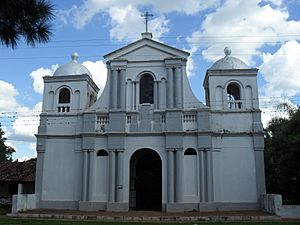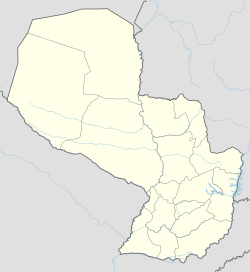Santiago, Paraguay facts for kids
Quick facts for kids
Santiago
|
|
|---|---|
|
City
|
|
| Santiago | |

Iglesia de Santiago
|
|
| Country | Paraguay |
| Department | Misiones |
| Re-founded | 1669 |
| Area | |
| • Total | 740 km2 (290 sq mi) |
| Elevation | 69 m (226 ft) |
| Population
(2008)
|
|
| • Total | 7,702 |
| • Density | 9/km2 (20/sq mi) |
| Time zone | UTC−04:00 |
| Code Postal |
4860
|
| Area code(s) | (595) (782) |
Santiago is a city in Paraguay. It is found in the Misiones Department in the southern part of the country.
Contents
Santiago's Name History
Santiago was first called San Ignacio de Caaguazú. It was given a new start in the Misiones Department of Paraguay in 1669. At that time, its name became Santiago Apostol.
Santiago's Rich History
Santiago is a very old city. It began as a settlement built by Jesuit missionaries. The city still shows signs of its past. You can see its large main square and the historic "house of the Indians." There is also a museum with art from the colonial period.
During the colonial times, Santiago was an important city. About 3,000 people lived there.
The city also hosted a big event called the Opera of Santiago. This showed how much the city loved culture and art.
Where is Santiago Located?
Santiago is 278 kilometers from Asunción. Asunción is the capital city of Paraguay. Santiago sits on a hill. It is between the cities of Ayolas and San Patricio.
The area around Santiago has rolling hills and many forests. There are also large grassy areas. Thick forests and farms surround the city. To the west is the Paraguayan Chaco. To the east is the Paraná Plateau.
The Tebicuary River is very important to Santiago. It provides water for farming. It is also used for transportation. Many types of fish live in the river. These fish help support the local fishing industry.
Santiago's Climate
In summer, the temperature in Santiago can reach 39 °C (102 °F). In winter, it can drop to 0 °C (32 °F). The average temperature for the whole year is 21 °C (70 °F).
Santiago has a subtropical climate. This means it has warm temperatures for most of the year. Cool air often comes from the south. This can make the weather change quickly. It can go from clear to stormy. In winter, some days and nights can be near freezing. But most winter days are cool or mild. It is rare for Santiago to have many days below freezing in one winter.
There is a clear rainy season from October to April. This brings plenty of rain to the area. The rain helps plants and crops grow well.
Santiago's Population
Santiago has 7,702 people living there. This includes 4,017 men and 3,685 women. These numbers come from the General Direction of Polls, Statistics and Census.
See also



